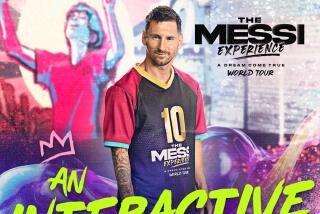A sport’s hustle, made timeless
- Share via
WASHINGTON — In the photograph, a late, low sun lights the stone wall where a Turkish woman sits, dark eyes downcast, intent on her knitting. Whizzing toward her, a muddy soccer ball is captured, frozen in flight. You almost want to call out, to warn her of the ball about to -- whap! ow! -- hit her in the face.
She is “unaware,” the placard reads, “of the incoming soccer ball.”
In soccer’s churning hustle, it’s easy to miss such moments.
Two soccer photography exhibits seek to remove us from the sensory overload of the World Cup and give us room to contemplate a game that otherwise allows no time for contemplation (which is, ironically, the beauty of the sport). Perhaps recognizing the need to appease action-oriented fans, both exhibits -- at the National Geographic Museum and the Goethe-Institut -- also offer World Cup viewing screens.
“With intense action, like soccer, a still photo allows the viewer to see nuance, grace, expression or beauty they might have missed,” says Chris Johns, editor in chief of National Geographic magazine. You know, the sort of nuance that’s missed when you’re stomping the bleachers at Olympic Stadium in Berlin or screaming at the lazy defender on a pub’s beer-splashed screen.
The Geographic exhibit, “Soccer: Planet at Play,” brings together 52 photos from the magazine’s archives. Meanwhile, 16 soccer field lengths across town at the Goethe-Institut, a German cultural venue, there is “Planet Football,” featuring 50 works by photographers with the Magnum Photos agency. The show is so similar to the Geographic’s that they even have a photograph in common. (A beached whaling ship in Burma is the audience for a pickup game, as photographed by Steve McCurry.)
Both show the sport to be more than the standard ESPN2 fare of neon-green fields and toned, muscled men. At Goethe, skinny kids jockey for a goal on a long strip of sand. Iranian women watch a high ball descend. Korean 5-year-olds bow before kickoff. A still photo, observes the exhibit’s coordinator, Sylvia Blume, “holds a moment that otherwise gets lost.”
Such moments at Goethe are often literally overlooked in favor of a television blaring live coverage of Cup competition in a “soccer lounge.”
The National Geographic exhibit in Explorers Hall offers a big-screen television in front of bleachers on a carpet of AstroTurf. The effect? A rowdy mini-arena that lures office workers and tourists from artful photographs to artful footwork.
Yang Xiao, visiting from China, stands apart from a loud group watching Korea top Togo. Pausing to contemplate a colorful snapshot of rain-soaked Haitian teenagers playing in the street, she says, “I’m interested in more than just soccer. I like this because it captures just the right moment.... I can almost hear their conversation.”
As you stroll past the images, they do seem to converse, to pass the ball to one another, as if the crowd of Argentines with eyes ecstatically bright, teeth grinding, are actually staring down the Haitian teens in the neighboring photo.
The most arresting images of soccer seem at first not to show soccer at all, but a playful dance, a visual manifestation of national struggle, and a reenactment of war. In this way the exhibits illuminate the World Cup for what it arguably is -- a giant, bloated metaphor. The Argentine onlookers, for all their frenzy and tension -- the whites of their knuckles clenched around the railing -- might as well be at a political uprising.
These exhibits suggest that for posterity, the sport bestows not just the tabloid shots of Brandi Chastain, praying at the altar of the goal posts, but images such as one by the Geographic’s Sarah Lean, of weeping men from San Pedro, Mexico, lowering a casket marked only with a jersey, its vertical stripes pointing down into the pit dug in the earth.
More to Read
Sign up for The Wild
We’ll help you find the best places to hike, bike and run, as well as the perfect silent spots for meditation and yoga.
You may occasionally receive promotional content from the Los Angeles Times.






